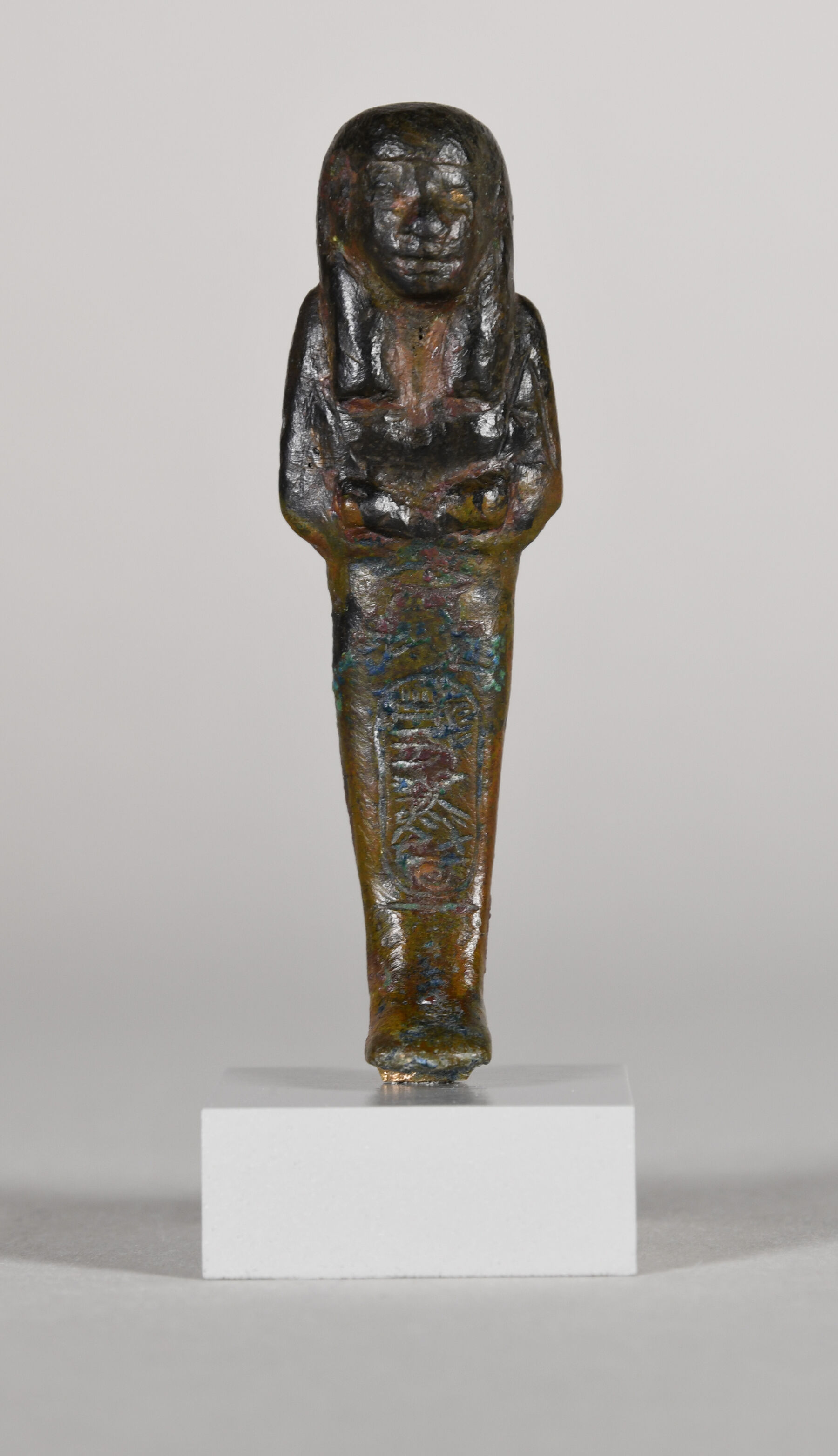This small bronze figure is one of at least 226 shabtis belonging to King Psusennes I.1 Psusennes, the son of Pinudjem I and Queen Henuttawy, who ruled half of Egypt from Tanis during Dynasty 21. At this time, the kingship of Egypt was split between a northern king in Tanis and the high priests of Amun in Karnak to the south. During Psusennes’s reign, his brother, Menkheperre, ruled coevally in Thebes during a time of relative prosperity.2
Psusennes I’s mummiform shabti stands at just under two inches (five centimeters) tall. He wears a lappet wig. His arms are crossed, and he holds an incised hoe in each hand. On his back, a small rectangular bag sits below his wig. Below the king’s arms, a single column of hieroglyphs reads, “The Osiris, King Pasebakhaenniwt (Psusennes I), beloved of Amun.” Bronze shabtis were uncommon in the Third Intermediate period. However, by having bronze shabtis, Psusennes I followed in the footsteps of the kings of the 19th and 20th Dynasties, Ramesses II and III.3
EW
-
Clayton, Peter A. 1970. “Two Ancient Egyptian Bronze Royal Shawabti Figures.” The Antiquaries Journal 50 (2): 347–8. https://doi.org/10.1017/S0003581500032017; Clayton, Peter A. 1972. “Royal Bronze Shawabti Figures.” JEA 58: 167–75. https://doi.org/10.2307/3856246. ↩︎
-
Broekman, Gerard P.F. 2002. “The founders of the Twenty-first Dynasty and their family relationships.” GM 191:11–18.; Taylor, John H. 2003. “The Third Intermediate Period (1069-664 BC).” In The Oxford History of Ancient Egypt, edited by Ian Shaw, 324–63. Oxford; New York: Oxford University Press.; Dodson, Aidan, and Dyan Hilton. 2004. The Complete Royal Families of Ancient Egypt. London; New York: Thames & Hudson.; Janes, G. 2020. The Amasis Collection: Shabtis and Other Artefacts from Ancient Egypt. Lymm: Olicar House.. ↩︎
-
Schneider, H.D. 1977. An Introduction to the History of Ancient Egyptian Funerary Statuettes with a Catalogue of the Collection of Shabtis in the National Museum of Antiquities at Leiden, vol. 1. Leiden: Rijksmuseum van Oudheden.; Stewart, H.M. 1995. Egyptian Shabtis. Shire Egyptology 23. Princes Risborough: Shire Publications. https://catalog.lib.uchicago.edu/vufind/Alphabrowse/Home?source=series&from=Ägyptologische+Abhandlungen. ↩︎
Bibliography
- Broekman 2002
- Broekman, Gerard P.F. 2002. “The founders of the Twenty-first Dynasty and their family relationships.” GM 191:11–18.
- Clayton 1970
- Clayton, Peter A. 1970. “Two Ancient Egyptian Bronze Royal Shawabti Figures.” The Antiquaries Journal 50 (2): 347–8. https://doi.org/10.1017/S0003581500032017
- Clayton 1972
- Clayton, Peter A. 1972. “Royal Bronze Shawabti Figures.” JEA 58: 167–75. https://doi.org/10.2307/3856246
- Dodson and Hilton 2004
- Dodson, Aidan, and Dyan Hilton. 2004. The Complete Royal Families of Ancient Egypt. London; New York: Thames & Hudson.
- Janes 2020
- Janes, G. 2020. The Amasis Collection: Shabtis and Other Artefacts from Ancient Egypt. Lymm: Olicar House.
- Schneider 1977a
- Schneider, H.D. 1977. An Introduction to the History of Ancient Egyptian Funerary Statuettes with a Catalogue of the Collection of Shabtis in the National Museum of Antiquities at Leiden, vol. 1. Leiden: Rijksmuseum van Oudheden.
- Stewart 1995
- Stewart, H.M. 1995. Egyptian Shabtis. Shire Egyptology 23. Princes Risborough: Shire Publications. https://catalog.lib.uchicago.edu/vufind/Alphabrowse/Home?source=series&from=Ägyptologische+Abhandlungen
- Taylor 2003
- Taylor, John H. 2003. “The Third Intermediate Period (1069-664 BC).” In The Oxford History of Ancient Egypt, edited by Ian Shaw, 324–63. Oxford; New York: Oxford University Press.
